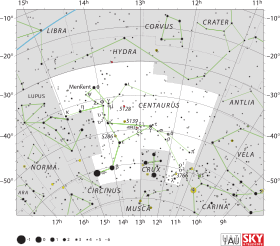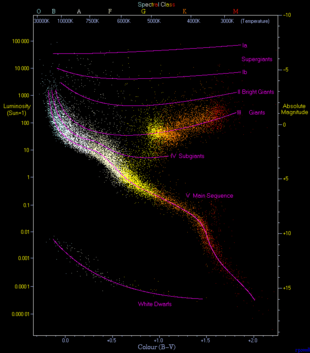HD 114613
HD 114613 (Gliese 501.2) is a fifth magnitude yellow subgiant that lies approximately 67 light-years away in the constellation of Centaurus. The star is host to a long-period giant planet, and may possibly be orbited by more.
 | |
| Observation data Epoch J2000.0 Equinox J2000.0 | |
|---|---|
| Constellation | Centaurus |
| Right ascension | 13h 12m 03.19s[1] |
| Declination | −37° 48′ 10.89″[1] |
| Apparent magnitude (V) | 4.852 ± 0.011[2] |
| Characteristics | |
| Spectral type | G4 IV[3] |
| B−V color index | 0.659 ± 0.020[2] |
| Astrometry | |
| Radial velocity (Rv) | -15.0 ± 0.9 km/s |
| Proper motion (μ) | RA: -381.72 ± 0.31[1] mas/yr Dec.: 45.75 ± 0.20[1] mas/yr |
| Parallax (π) | 48.38 ± 0.29[1] mas |
| Distance | 67.4 ± 0.4 ly (20.7 ± 0.1 pc) |
| Absolute magnitude (MV) | 3.29[4] |
| Details | |
| Mass | 1.25 ± 0.03[5] M☉ |
| Radius | 2.01 ± 0.06[5] R☉ |
| Luminosity | 4.057 ± 0.014[6] L☉ |
| Surface gravity (log g) | 3.97 ± 0.02[6] cgs |
| Temperature | 5729 ± 17[6] K |
| Metallicity [Fe/H] | 0.19 ± 0.01[6] dex |
| Rotation | 34.1 ± 3.5 days[7] |
| Rotational velocity (v sin i) | 2.4 ± 0.5[8] km/s |
| Age | 5.20 ± 0.24[5] Gyr |
| Other designations | |
| Database references | |
| SIMBAD | data |
Stellar characteristics

HD 114613 lies about eight arcminutes south-east of Iota Centauri, towards the middle of Centaurus. Though it is fairly easily observable with the naked eye, the star does not have a Bayer or Flamsteed designation as the constellation of Centaurus contains many brighter stars.
The B-V colour and spectroscopic temperature of HD 114613 correspond with its spectral type of G4. This means that the star is only slightly cooler than the Sun, and has the yellow hue typical of G-type stars. On the Hertzsprung-Russell diagram (left) the star lies significantly above the main sequence, and is close to the subgiant branch; this means that HD 114613 has depleted the hydrogen in its core through nuclear fusion, and is increasing in radius while decreasing in temperature as it moves towards the giant branch.
As HD 114613 is ending hydrogen fusion, the star must be fairly old. When combined with a spectroscopically-derived mass of 1.25 ± 0.03 M☉ and a surface gravity of log 3.95 ± 0.03 g the implied age of the star is 5.20 ± 0.24 billion years,[5] making it slightly older than the Sun. Though stellar metallicities typically decrease with increasing stellar age, within the age range of the thin disk a wide range of metallicities are common; HD 114613's high iron abundance of 0.19 ± 0.01 dex (155 ± 4% of the solar abundance) is therefore not unusual. The rate of giant planet occurrence for Fe/H = 0.2 dex stars is about 15%,[9] which makes it fairly unsurprising that the star hosts a giant planet.
HD 114613 has a magnetic cycle with a period of 897 ± 61 days, about four-and-a-half times shorter than the Solar magnetic cycle and one of the shortest magnetic cycles known.[7]
Planet searches
Being bright and solar-type, HD 114613 is an attractive target for radial velocity (RV)-based planet searches.
HD 114613 was one of the 37 targets of the first RV-based planet search in the southern hemisphere, the ESO-CES survey that spanned between 1992 and 1998.[10] This survey did not detect any companion with several Jovian masses out to a few AU. An extension of this survey to the HARPS spectrograph provides further constraint, suggesting that there are no Jupiter-mass companions out to about 5 AU.[11]
HD 114613 is included in the samples of the ESO-CORALIE[9] and AAT-UCLES[12] planet searches that both began in 1998. Seemingly finding the star to be RV-stable and suitable for higher precision, HD 114613 was included in a subset of the CORALIE sample that became the sample of the ESO-HARPS high precision planet search that began in 2004,[6] while the star was elevated in importance in the AAT sample in 2005.[13][14] Though apparently not included in its main sample, HD 114613 is included in the sample of the Keck-HIRES Eta-Earth low-mass planet search that also began in 2004.[15]
Planetary system
In Wittenmyer et al. 2012,[16] HD 114613 is indicated to be a low-mass planet host. Though this references a Tuomi et al. 2012 (Tuomi, M., et al. 2012, MNRAS, submitted), no such paper was published that year. More recently, in a Tuomi et al. 2013,[17] Tau Ceti is noted to have a similar activity index distribution to HD 114613. Again, a Tuomi et al. 2012 is referenced, though somewhat more completely (Tuomi, M., Jones, H. R. A., Jenkins, J. S., et al. 2012, MNRAS, submitted). No paper announcing HD 114613 as a low-mass planet host has been published as of 2014.
However, that does not mean the star is not a planet host. Wittenmyer et al. (2014) found HD 114613 to show a moderate-amplitude variation in its radial velocity with a period of 10.5 years, indicative of a long-period companion.[18] The radial velocity semi-amplitude of 5.5 m/s translates to a planet with a minimum mass about half a Jupiter mass. The planet has an intermediate orbital eccentricity of 0.25, which means that it can be somewhat loosely considered a Jupiter analogue.
| Companion (in order from star) |
Mass | Semimajor axis (AU) |
Orbital period (days) |
Eccentricity | Inclination | Radius |
|---|---|---|---|---|---|---|
| b | ≥0.48 ± 0.04 MJ | 5.16 ± 0.13 | 3827 ± 105 | 0.25 ± 0.08 | — | — |
References
- van Leeuwen, F. (2007). "Validation of the new Hipparcos reduction". Astronomy and Astrophysics. 474 (2): 653–664. arXiv:0708.1752. Bibcode:2007A&A...474..653V. doi:10.1051/0004-6361:20078357.
- Høg, E.; et al. (2000). "The Tycho-2 catalogue of the 2.5 million brightest stars". Astronomy and Astrophysics. 355: 27–30. Bibcode:2000A&A...355L..27H. doi:10.1888/0333750888/2862. ISBN 0333750888.
- Gray, R. O.; Corbally, C. J.; Garrison, R. F.; McFadden, M. T.; Bubar, E. J.; McGahee, C. E.; O'Donoghue, A. A.; Knox, E. R. (2006). "Contributions to the Nearby Stars (NStars) Project: Spectroscopy of Stars Earlier than M0 within 40 pc-The Southern Sample". The Astronomical Journal. 132: 161. arXiv:astro-ph/0603770. Bibcode:2006AJ....132..161G. doi:10.1086/504637.
- Pace, G.; Pasquini, L.; Ortolani, S. (2003). "The Wilson–Bappu effect: A tool to determine stellar distances". Astronomy & Astrophysics. 401 (3): 997. arXiv:astro-ph/0301637. Bibcode:2003A&A...401..997P. doi:10.1051/0004-6361:20030163.
- Takeda, Genya; et al. (2007). "Structure and Evolution of Nearby Stars with Planets. II. Physical Properties of ~1000 Cool Stars from the SPOCS Catalog". The Astrophysical Journal Supplement Series. 168 (2): 297–318. arXiv:astro-ph/0607235. Bibcode:2007ApJS..168..297T. doi:10.1086/509763.
- Sousa, S. G.; et al. (August 2008). "Spectroscopic parameters for 451 stars in the HARPS GTO planet search program. Stellar [Fe/H] and the frequency of exo-Neptunes". Astronomy and Astrophysics. 487 (1): 373–381. arXiv:0805.4826. Bibcode:2008A&A...487..373S. doi:10.1051/0004-6361:200809698.
- Lovis, C.; et al. (2011). "The HARPS search for southern extra-solar planets. XXXI. Magnetic activity cycles in solar-type stars: statistics and impact on precise radial velocities". arXiv:1107.5325 [astro-ph.SR].
- Valenti, J. A.; et al. (2005). "Spectroscopic Properties of Cool Stars (SPOCS). I. 1040 F, G, and K Dwarfs from Keck, Lick, and AAT Planet Search Programs". The Astrophysical Journal Supplement Series. 159 (1): 141–166. Bibcode:2005ApJS..159..141V. doi:10.1086/430500.
- Mortier, A.; et al. (2013). "On the functional form of the metallicity-giant planet correlation". Astronomy & Astrophysics. 551: A112. arXiv:1302.1851. Bibcode:2013A&A...551A.112M. doi:10.1051/0004-6361/201220707.
- Endl, M.; et al. (2002). "The planet search program at the ESO Coudé Echelle spectrometer. III. The complete Long Camera survey results". Astronomy & Astrophysics. 392 (2): 671–690. arXiv:astro-ph/0207512. Bibcode:2002A&A...392..671E. doi:10.1051/0004-6361:20020937.
- Zechmeister, M.; et al. (2013). "The planet search programme at the ESO CES and HARPS. IV. The search for Jupiter analogues around solar-like stars". Astronomy & Astrophysics. 592: A78. arXiv:1211.7263. Bibcode:2013A&A...552A..78Z. doi:10.1051/0004-6361/201116551.
- Jones, Hugh R. A.; et al. (2002). "Extrasolar planets around HD 196050, HD 216437 and HD 160691". Monthly Notices of the Royal Astronomical Society. 337 (4): 1170–1178. arXiv:astro-ph/0206216. Bibcode:2002MNRAS.337.1170J. doi:10.1046/j.1365-8711.2002.05787.x.
- Wittenmyer, Robert A.; et al. (2010). "The Frequency of Low-mass Exoplanets. II. The "Period Valley"". The Astrophysical Journal. 722 (2): 1854–1863. arXiv:1008.5232. Bibcode:2010ApJ...722.1854W. doi:10.1088/0004-637X/722/2/1854.
- Wittenmyer, Robert A.; et al. (2011). "The Frequency of Low-mass Exoplanets. III. Toward η⊕ at Short Periods". The Astrophysical Journal. 738 (1): 81. arXiv:1103.4186. Bibcode:2011ApJ...738...81W. doi:10.1088/0004-637X/738/1/81.
- Howard, Andrew A.; et al. (2010). "The Occurrence and Mass Distribution of Close-in Super-Earths, Neptunes, and Jupiters". Science. 330 (6004): 653–655. arXiv:1011.0143. Bibcode:2010Sci...330..653H. doi:10.1126/science.1194854. PMID 21030652.
- Wittenmyer, Robert A.; et al. (2012). "The Anglo-Australian Planet Search. XXII. Two New Multi-planet Systems". The Astrophysical Journal. 753 (2): 169. arXiv:1205.2765. Bibcode:2012ApJ...753..169W. doi:10.1088/0004-637X/753/2/169.
- Tuomi, M.; et al. (2013). "Signals embedded in the radial velocity noise. Periodic variations in the τ Ceti velocities". Astronomy & Astrophysics. 551: A79. arXiv:1212.4277. Bibcode:2013A&A...551A..79T. doi:10.1051/0004-6361/201220509.
- Wittenmyer, Robert A.; et al. (2014). "The Anglo-Australian Planet Search. XXIII. Two New Jupiter Analogs". The Astrophysical Journal. 783 (2): 103. arXiv:1401.5525. Bibcode:2014ApJ...783..103W. doi:10.1088/0004-637X/783/2/103.